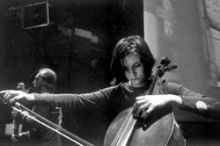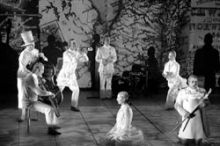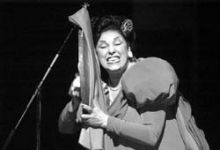Contemporary music is a rather controversial notion. In the mass consciousness and in the press, which caters to this mentality, it can mean modern, popular, rock, hip-hop, etc.
Meanwhile, the profound basis of all music culture-profound because of its very elemental nature-still consists of composers’ creativeness, as in the days of Bach, Mozart, and Mahler. This is what is called academic music, for want of a better definition. However, of all the “academies” that prevail in the various arts, this one is the most important, paradoxical, and unpredictable of all. Experimentation here does not mean violating canons, but abiding by an unwritten rule, and the uniformity of faces, gestures, and sound to which mass culture adheres with such zeal is impossible by definition.
Meanwhile, works by contemporary composers, which are in principle non-mass in nature, are rarely featured in the programs of philharmonic societies. Therefore, festivals are the venues where current music comes alive. This is especially true of Dresden’s Days of Contemporary Music.
The specific features of this festival are hard to understand out of context-outside the city that was hosting the event. Dresden’s uniqueness lies in the tangible presence of several historical eras: the period of the legendary Augustus II the Strong, whose achievements brought Dresden renown as the “Florence on the Elbe”; the unhealed memories of the Allied air raids in 1945, which razed Dresden to the ground. Another less disastrous but equally traumatic experience was being part of the Soviet bloc for more than forty years. This experience is still present in the local landscape in the form of numerous architectural monstrosities that are painfully reminiscent of Brezhnev’s nine-story blocks of flats. These buildings contrast with the new global realities present in the high-tech glass-and-steel structures of factories and offices that were built after Germany’s reunification. These crisscrossing epochs, of course, have affected the festival’s geography; concerts are held at the “DreikЪnigskirche” [Three Kings’ Church]. This 600-year-old structure, which was reduced to rubble after the Allied air raid, except for the stucco altar, has been completely rebuilt. Other concerts took place at an ultramodern synagogue erected only a few years ago, but mostly at the Festspielhaus Hellerau. This structure was built in the early twentieth century, in a convincingly neoclassical style noticeably marked by the motley local history. In the 1920s it housed a ballet school, among whose students was the future movie star and the top Nazi film director Leni Riefenstahl. Later, it housed an SS unit, and after WWII a Soviet military unit. The concert hall was then converted into a gym. Even now you can spot Russian graffiti on its walls with messages like “Demob. Kiev. 1983-85.”
The Contemporary Music Days festival also boasts an eventful history. The festival, which dates back to Honecker’s German Democratic Republic, was first held as a Festival of Friendship of Musicians from Fraternal Countries. Eventually, the socialist accent was replaced with a Western one, and the quality of purely Dresden historicity turned into a festival that is open to new trends and young talent.
Today’s Contemporary Music Days features a variety of programs, with its own system of grants and scholarships, seminars and colloquiums involving composers and musicians from Europe, Asia, even Latin America, who study and create works. In fact, this multilingualism and assortment of music and national temperaments are the festival’s notable features.
This accounts for the festival’s conceptual structure. The main concerts are not selected simply according to certain works: they are also directed as special performances, each time with new stage props and a special atmosphere.
The 18th festival began with a soiree featuring four operas. The four mini-operas by four different composers were divided into equal fragments and performed in an unusual cyclical pattern. The result was a truly unified whole resembling a dramatic canvas woven with absolutely different motifs and moods. Benjamin Schweitzer’s expressive and noisy Informationen uber Bartleby followed Michael Hirsch’s tragedy La Didone Abbandonata. There suddenly erupted Charlotte Seither’s funny and inventive grotesque one-woman opera Sieh di Sonn, in which the singer fashioned incredible sounds with most unusual instruments. All this was layered over with Moscow’s Tamara Ibragimova’s melancholy Astride the Bucket, based on a Kafka short story. A similar European-style soiree featured three works devoted to Europe’s historical, cultural, and political mythology, in which video was paired with music. These works required some dramatic talent from the musicians and actors, especially in Agnes Ponizil’s interesting Eu-R-Oper. A highly dramatic effect was created when the cast, clad in chimerical white costumes, appeared in what seemed to be an audio-video ritual against a backdrop of ancient maps of the Old World.
Music, however, predominated. No less interesting were the soirees united by theme, genre, even geography, including the Global Ear Concert, which featured modern Chinese compositions, combining avant-garde and old traditional motifs. Complementing this remarkable music were instruments, like the mouth organ. Noteworthy was the French ensemble Alef, whose repertoire consisted entirely of short works by young composers from literally every continent, ranging from Mexico to the United States to Russia. It was gratifying to witness Ukraine’s tangible and compelling presence. During the concert “Organ Music from Russia, Azerbaijan, and Ukraine,” Volodymyr Runchak’s two-part opus sounded very good. Lviv composer Oleksandr Kozarenko’s Old Wuisburg Dances and St. Kylian’s Bells proved a worthy addition to the Schlagzeugensemble Freiburg Concert.
The pass_PORT Ukrainian-Macedonian-German performance turned out to be a major event of the festival. From the outset the organizers had billed it as a key show and did not stint on advertising: striking posters advertising the show were all over the city, resulting in a packed Festspielhaus Hellerau and much press coverage. The project was dedicated to traveling, crossing political and cultural borders, and attendant conflicts. Complementing the music were associative abstract video effects showing roads and highways, and incessant traffic. An important component of the show was a stereoscopic view, as though taken on both sides of the former Iron Curtain, from Germany, Macedonia, and Ukraine. The German- Ukrainian ensemble gave a brilliant performance, which included some very complicated scores. Once again, it was gratifying to know that Ukrainian composer Svitlana Azarova and her Macedonian counterpart Darja Andovska helped raise pass_PORT from the level of mundane pamphlet to the superior level of a parable; this was a musical drama about estrangement and the frontiers that separate countries as well as hearts. Such convincing, heartfelt messages from composers to their audiences are perhaps the key objective of any creative work, regardless of genre or technique.
In olden days, gates were the greatest possession, protection, and symbol of every city; he who owned the key owned everything else. Today’s Dresden Crown Gate is a crossroads of different cultures and epochs, which is always kept open. All you have to do to enter through this gate is to have talent and courage. It is very gratifying to realize that our young composers and performers have such talent and courage, notwithstanding all the talk about European integration.











